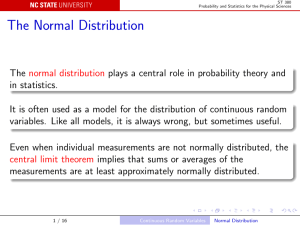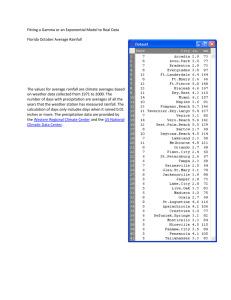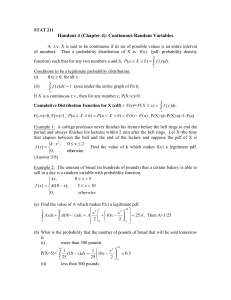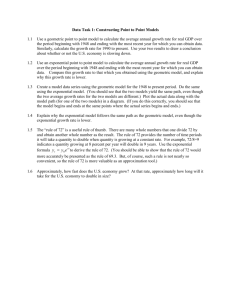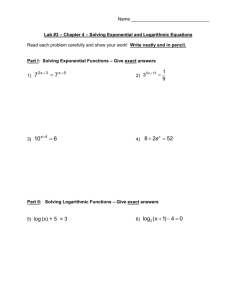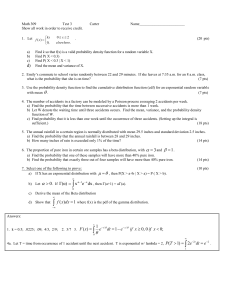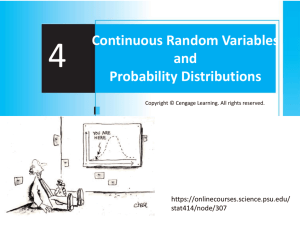Solutions 1
advertisement
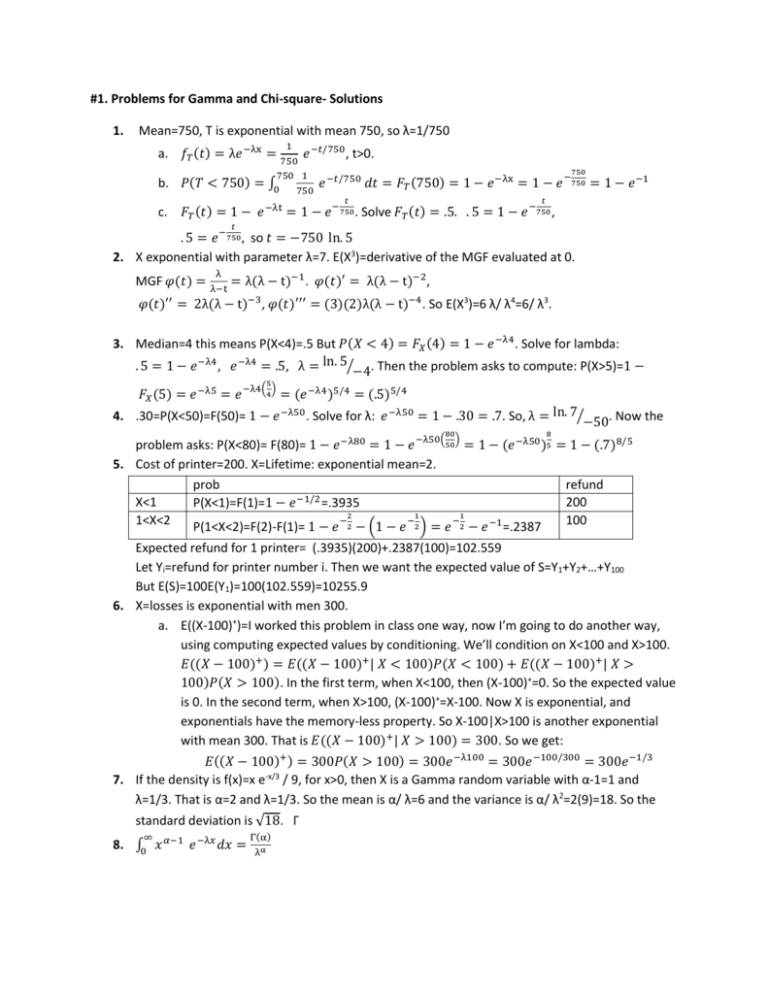
#1. Problems for Gamma and Chi-square- Solutions 1. Mean=750, T is exponential with mean 750, so λ=1/750 1 a. 𝑓𝑇 (𝑡) = λ𝑒 −λx = 750 𝑒 −𝑡/750, t>0. 750 1 750 b. 𝑃(𝑇 < 750) = ∫0 750 𝑒 −𝑡/750 𝑑𝑡 = 𝐹𝑇 (750) = 1 − 𝑒 −λx = 1 − 𝑒 −750 = 1 − 𝑒 −1 𝑡 𝑡 c. 𝐹𝑇 (𝑡) = 1 − 𝑒 −λt = 1 − 𝑒 −750 . Solve 𝐹𝑇 (𝑡) = .5. . 5 = 1 − 𝑒 −750 , 𝑡 . 5 = 𝑒 −750 , so 𝑡 = −750 ln. 5 2. X exponential with parameter λ=7. E(X3)=derivative of the MGF evaluated at 0. λ MGF 𝜑(𝑡) = λ−t = λ(λ − t)−1 . 𝜑(𝑡)′ = λ(λ − t)−2, 𝜑(𝑡)′′ = 2λ(λ − t)−3 , 𝜑(𝑡)′′′ = (3)(2)λ(λ − t)−4. So E(X3)=6 λ/ λ4=6/ λ3. 3. Median=4 this means P(X<4)=.5 But 𝑃(𝑋 < 4) = 𝐹𝑋 (4) = 1 − 𝑒 −λ4. Solve for lambda: . 5 = 1 − 𝑒 −λ4 , 𝑒 −λ4 = .5, λ = ln. 5⁄−4. Then the problem asks to compute: P(X>5)=1 − 𝐹𝑋 (5) = 𝑒 −λ5 = 𝑒 5 4 −λ4( ) = (𝑒 −λ4 )5/4 = (.5)5/4 4. .30=P(X<50)=F(50)= 1 − 𝑒 −λ50. Solve for λ: 𝑒 −λ50 = 1 − .30 = .7. So, λ = ln. 7⁄−50. Now the 80 −λ50( ) 8 50 = 1 − (𝑒 −λ50 )5 = 1 − (.7)8/5 problem asks: P(X<80)= F(80)= 1 − 𝑒 −λ80 = 1 − 𝑒 5. Cost of printer=200. X=Lifetime: exponential mean=2. prob refund −1/2 X<1 200 P(X<1)=F(1)=1 − 𝑒 =.3935 2 1 1 1<X<2 100 P(1<X<2)=F(2)-F(1)= 1 − 𝑒 −2 − (1 − 𝑒 −2 ) = 𝑒 −2 − 𝑒 −1=.2387 Expected refund for 1 printer= (.3935)(200)+.2387(100)=102.559 Let Yi=refund for printer number i. Then we want the expected value of S=Y1+Y2+…+Y100 But E(S)=100E(Y1)=100(102.559)=10255.9 6. X=losses is exponential with men 300. a. E((X-100)+)=I worked this problem in class one way, now I’m going to do another way, using computing expected values by conditioning. We’ll condition on X<100 and X>100. 𝐸((𝑋 − 100)+ ) = 𝐸((𝑋 − 100)+ | 𝑋 < 100)𝑃(𝑋 < 100) + 𝐸((𝑋 − 100)+ | 𝑋 > 100)𝑃(𝑋 > 100). In the first term, when X<100, then (X-100)+=0. So the expected value is 0. In the second term, when X>100, (X-100)+=X-100. Now X is exponential, and exponentials have the memory-less property. So X-100|X>100 is another exponential with mean 300. That is 𝐸((𝑋 − 100)+ | 𝑋 > 100) = 300. So we get: 𝐸((𝑋 − 100)+ ) = 300𝑃(𝑋 > 100) = 300𝑒 −λ100 = 300𝑒 −100/300 = 300𝑒 −1/3 7. If the density is f(x)=x e-x/3 / 9, for x>0, then X is a Gamma random variable with α-1=1 and λ=1/3. That is α=2 and λ=1/3. So the mean is α/ λ=6 and the variance is α/ λ2=2(9)=18. So the standard deviation is √18. Γ ∞ 8. ∫0 𝑥 𝛼−1 𝑒 −λ𝑥 𝑑𝑥 = Γ(α) λα ∞ a. To compute ∫0 𝑥 3/2 𝑒 −2𝑥 𝑑𝑥, identify the parameters: α-1=3/2 and λ=2. So the answer is = Γ(5/2) 25/2 ∞ ∞ b. To compute ∫0 5 𝑡 3 𝑒 −𝑡 𝑑𝑡 = 5 ∫0 𝑡 3 𝑒 −𝑡 𝑑𝑡, , identify the parameters: α-1=3 and λ=1. So we get: 5 Γ(4) 14 = 5(3!) = 30. Recall: Γ(n) = 𝑛 − 1! When n is a positive integer. 9. Γ(n) = 𝑛 − 1! So Γ(5) = 4! = 24 Γ(x) = (𝑥 − 1) Γ(x − 1) so, we know Γ(. 5) = √𝜋 , so we can figure out by using the property of the Gamma: Γ(3.5) = 2.5Γ(2.5) = (2.5)(1.5)Γ(1.5) = (2.5)(1.5)(. 5)Γ(. 5) = (2.5)(1.5)(.5)√𝜋 10. X is Gamma with parameters α=6, λ=1/2. a. E(X)= α/ λ=12, Var(X)= α/ λ2=24. ∞ b. E(X3) = third derivative of MGF or we can use the formula: ∫0 𝑥 𝛼−1 𝑒 −λ𝑥 𝑑𝑥 = Γ(α) λα 1 ∞ (2)6 𝑥 𝑥 1 1 Γ(9) 29 Γ(9) =∫ 𝑥 𝑥 6−1 𝑒 −2 𝑑𝑥 = 6 ∫ 𝑥 9−1 𝑒 −2 𝑑𝑥 = 6 = Γ(6) 2 Γ(6) 0 2 Γ(6) 1 9 26 Γ(6) 0 ( ) 2 8! = 23 5! ∞ 𝐸(𝑋 3) 3 c. 1 ∞ (2)6 𝑥 𝑥 1 1 Γ(6.5) 𝐸(√𝑋) = ∫ 𝑥 𝑥 6−1 𝑒 −2 𝑑𝑥 = 6 ∫ 𝑥 6.5−1 𝑒 −2 𝑑𝑥 = 6 Γ(6) 2 Γ(6) 0 2 Γ(6) 1 6.5 0 (2) Γ(6.5) = 20.5 Γ(6) 𝑛 2 11. 𝑆 = ∑𝑖=1 𝑍𝑖 is Chi-squared with n degrees of freedom. ∞ 1/2 a. When n=5, S is Chi-squared with 5 df. Var(S)=10 so 𝜎𝑆 = √10, and 5√2𝜎𝑆 = 10√5=22.36. Thus, 𝑃(𝑆 < 5√2𝜎𝑆 ) = 𝑃(𝑆 < 22.26)~1 looking at the table for the chisquare with 5 df. b. When n=100, we can use the CLT. Let Xi=Zi2. Then S/100=𝑋̅. Notice that Xi = Zi2 is chisquare with df=1. So, its mean=E(Xi)=1, and its variance Var(Xi)=2. Now, since S is chisquare with df=100, Var(S)=200 and 𝜎𝑆 = √200 , so 5√2𝜎𝑆 = 100. Thus 𝑃(𝑆 < 5√2𝜎𝑆 ) = 𝑃(𝑆 < 100) = 𝑃(𝑋̅ < 1) = 𝑃 = .5 (𝑋̅ − 𝜇) (1 − 1) < ≅ 𝑃(𝑍 < 0) 𝜎 √2 √𝑛 √100 ) (


